Lyons W.C. (ed.). Standard handbook of petroleum and natural gas engineering.2001- Volume 1
Подождите немного. Документ загружается.

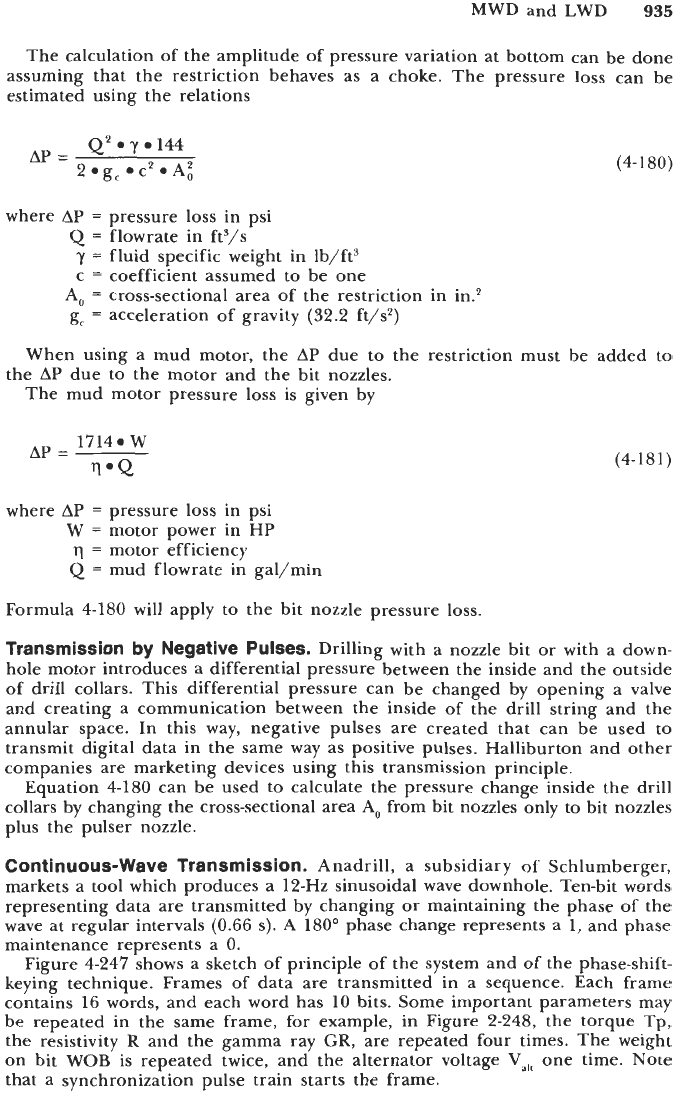
MWD and LWD
935
The calculation of the amplitude of pressure variation at bottom can be done
assuming that the restriction behaves as a choke. The pressure
loss
can be
estimated using the relations
Q'
y
144
2.g,.c2.A~
AP
=
(4-1
80)
where
AP
=
pressure loss in psi
Q
=
flowrate in ft5/s
y
=
fluid specific weight in lb/ft3
c
=
coefficient assumed to be one
A,,
=
cross-sectional area of the restriction in
g,
=
acceleration of gravity (32.2 ft/s2)
When using a mud motor, the
AP
due to the restriction must be added
to
the
AP
due to the motor and the bit nozzles.
The mud motor pressure loss is given by
(4-1 8
1)
where
AP
=
pressure loss in psi
W
=
motor power in
HP
q
=
motor efficiency
Q
=
mud flowrate in gal/min
Formula 4-180 will apply to the bit nozzle pressure loss.
Transmission by Negative Pulses.
Drilling with a nozzle bit or with a down-
hole motor introduces a differential pressure between the inside and the outside
of drill collars. This differential pressure can be changed by opening a valve
and creating a communication between the inside of the drill string and the
annular space. In this way, negative pulses are created that can be used
to
transmit digital data in the same way as positive pulses. Halliburton and other
companies are marketing devices using this transmission principle.
Equation 4-180 can be used to calculate the pressure change inside the drill
collars by changing the cross-sectional area
A,,
from bit nozzles only to bit nozzles
plus the pulser nozzle.
Continuous-Wave Transmission.
Anadrill, a subsidiary of Schlumberger,
markets a tool which produces a 12-Hz sinusoidal wave downhole. Ten-bit words
representing data are transmitted by changing or maintaining the phase
of
the
wave at regular intervals (0.66
s).
A
180' phase change represents a
1,
and phase
maintenance represents a
0.
Figure 4-247 shows a sketch of principle of the system and of the phase-shift-
keying technique. Frames of data are transmitted in a sequence. Each frame
contains 16 words, and each word has
10
bits. Some important parameters may
be repeated in the same frame, for example, in Figure 2-248, the torque Tp,
the resistivity
R
and the gamma ray
GR,
are repeated four times. The weight
on bit WOB is repeated twice, and the alternator voltage
Val,
one time. Note
that a synchronization pulse train starts the frame.

936
Drilling
and
Well
Completions
TiWU
____)
Clock
24Hz
I
Clock bit
"
n
n
Figure
4-247.
Principle
of
the continuous wave system: (a) sketch
of
the
siren and electronic block diagram; (b) principle
of
the coding by phase shift
keying.
(Courtesy
Anadrill
[106].)
binary
weight
32
64
120
256
512
3
0
110100000
A#%m,VMMMnl*~~
I
I
.
I
...
.
f
,T;
le
I
1
frame
*I
I
I
(16
words)
I
I
(1280
cycla3
-
106.7
secoiids)
Figure
4-248.
Example
of
a frame
of
data transmitted by the continuous
wave system.
(Courtesy
Anadrill
[106].)
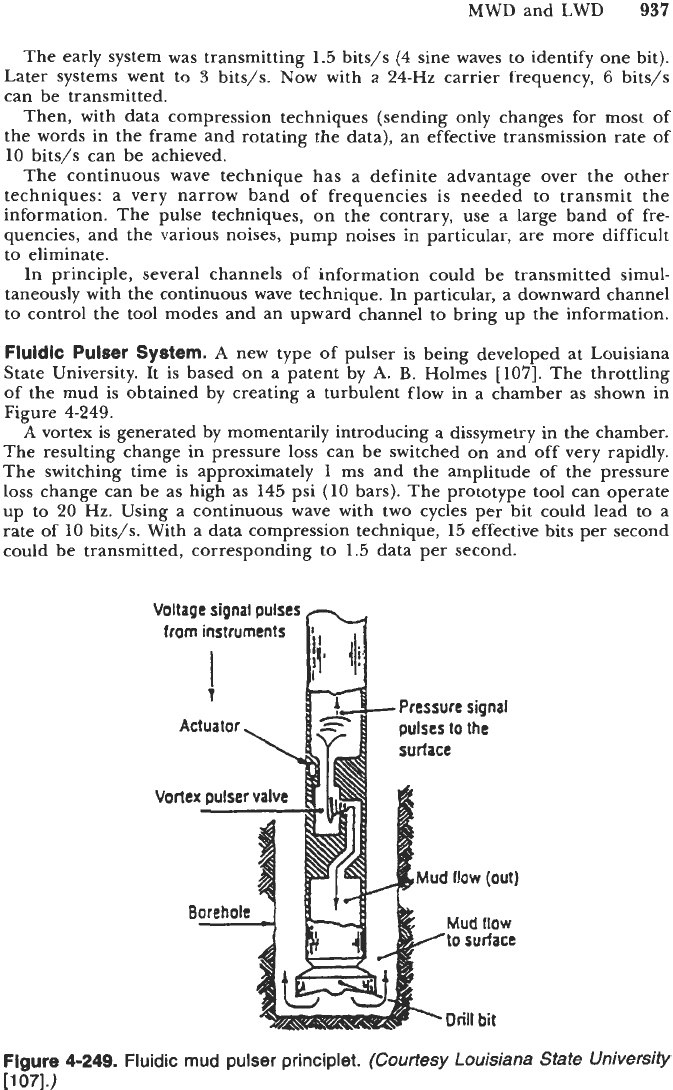
MWD and LWD
937
The early system was transmitting
1.5
bits/s
(4
sine waves to identify one bit).
Later systems went to
3
bits/s. Now with a
24-Hz
carrier frequency,
6
bits/s
can be transmitted.
Then, with data compression techniques (sending only changes for most of
the words in the frame and rotating the data), an effective transmission rate
of
10
bits/s can be achieved.
The continuous wave technique has a definite advantage over the other
techniques: a very narrow band of frequencies is needed to transmit the
information. The pulse techniques, on the contrary, use a large band of fre-
quencies, and
the
various noises, pump noises in particular, are more difficult
to eliminate.
In principle, several channels of information could be transmitted simul-
taneously with the continuous wave technique. In particular, a downward channel
to control the tool modes and an upward channel to bring up the information.
Fluidic Pulser System.
A
new type of pulser is being developed at Louisiana
State University. It is based on a patent by
A.
B.
Holmes
[lo?’].
The throttling
of the mud is obtained by creating a turbulent flow in a chamber as shown in
Figure
4-249.
A
vortex is generated by momentarily introducing a dissymetry in the chamber.
The resulting change in pressure
loss
can be switched on and off very rapidly.
The switching time is approximately
1
ms and the amplitude of the pressure
loss
change can be as high as
145
psi
(10
bars). The prototype tool can operate
up to
20
Hz.
Using a continuous wave with two cycles per bit could lead to a
rate of
10
bits/s. With a data compression technique,
15
effective bits per second
could be transmitted, corresponding to
1.5
data per second.
Voltage signal
pulses
from instruments
Figure
4-249.
Fluidic mud pulser principlet.
(Courtesy
Louisiana
State
University
11
071.1
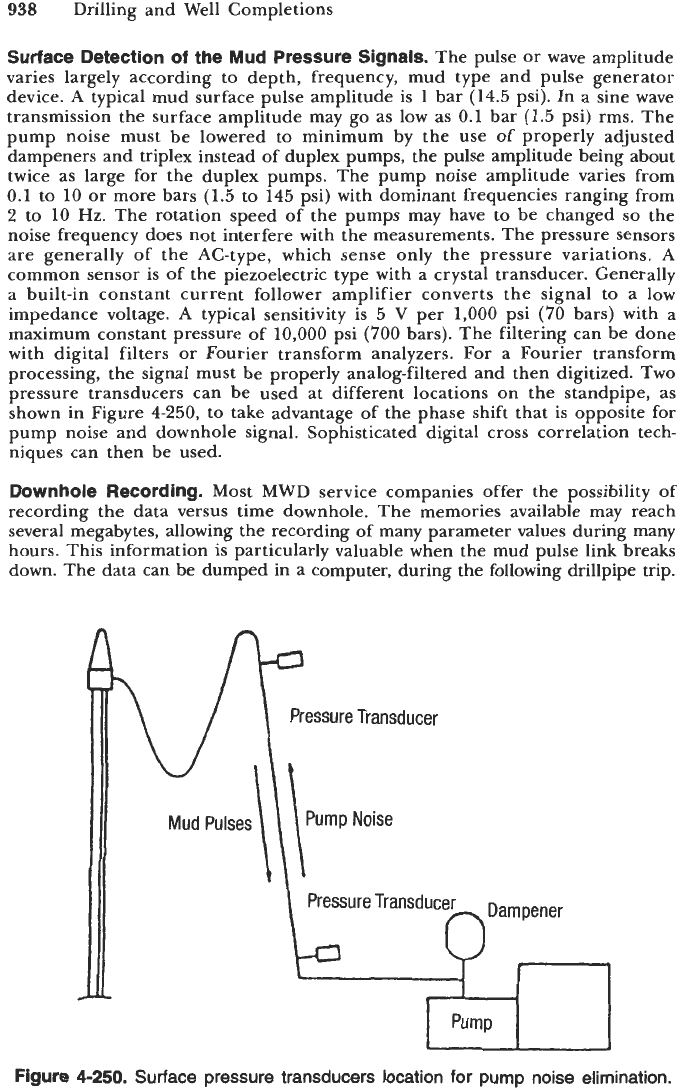
938
Drilling and Well Completions
Surface Detection
of
the Mud Pressure Signals.
The pulse
or
wave amplitude
varies largely according to depth, frequency, mud type and pulse generator
device.
A
typical mud surface pulse amplitude is 1 bar (14.5 psi).
In
a sine wave
transmission the surface amplitude may go as low as
0.1
bar (1.5 psi) rms. The
pump noise must be lowered to minimum by the use of properly adjusted
dampeners and triplex instead of duplex pumps, the pulse amplitude being about
twice as large for the duplex pumps. The pump noise amplitude varies from
0.1 to 10
or
more bars (1.5 to 145 psi) with dominant frequencies ranging from
2
to 10 Hz. The rotation speed of the pumps may have to be changed
so
the
noise frequency does not interfere with the measurements. The pressure sensors
are generally of the AC-type, which sense only the pressure variations.
A
common sensor is of the piezoelectric type with
a
crystal transducer. Generally
a built-in constant current follower amplifier converts the signal to
a
low
impedance voltage.
A
typical sensitivity is 5
V
per 1,000 psi
(70
bars) with a
maximum constant pressure of 10,000 psi
(700
bars). The filtering can be done
with digital filters
or
Fourier transform analyzers. For a Fourier transform
processing, the signal must be properly analog-filtered and then digitized. Two
pressure transducers can be used at different locations on the standpipe, as
shown in Figure 4-250, to take advantage of the phase shift that is opposite for
pump noise and downhole signal. Sophisticated digital cross correlation tech-
niques can then be used.
Downhole Recording.
Most MWD service companies offer the possibility of
recording the data versus time downhole. The memories available may reach
several megabytes, allowing the recording of many parameter values during many
hours. This information is particularly valuable when the mud pulse link breaks
down. The data can be dumped in a computer, during the following drillpipe trip.
Figure
4-250.
Surface pressure transducers location
for
pump noise elimination.
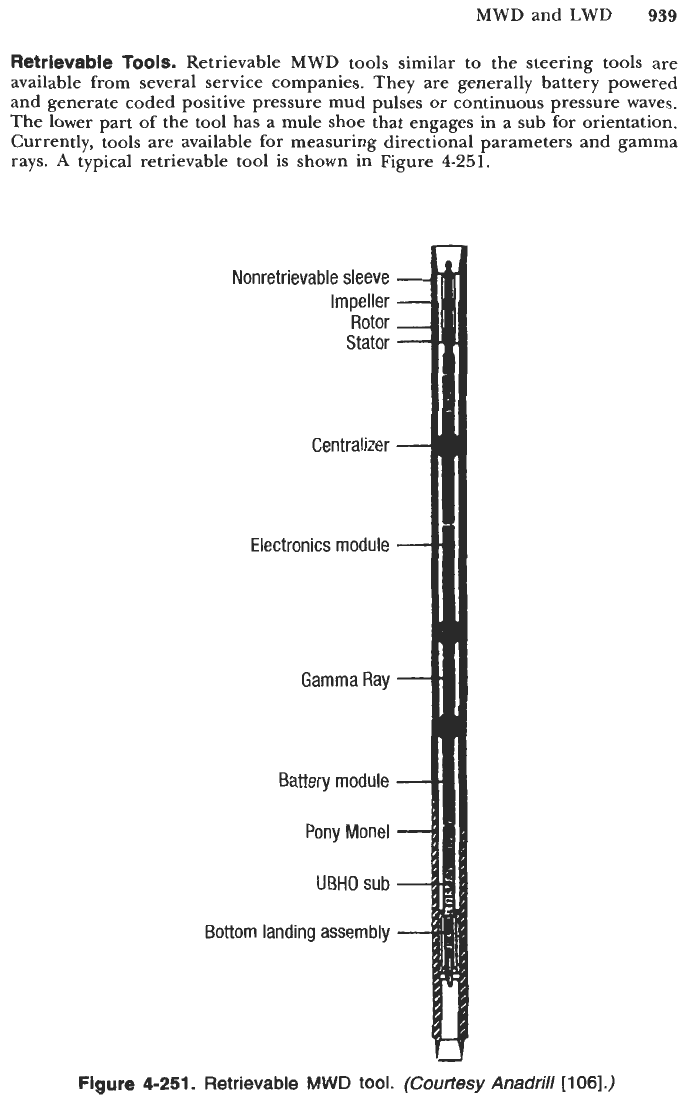
MWD and LWD
939
Retrievable
Tools.
Retrievable MWD tools similar to the steering tools are
available from several service companies. They are generally battery powered
and generate coded positive pressure mud pulses or continuous pressure waves.
The lower part of the tool has a mule shoe that engages in a sub for orientation.
Currently, tools are available for measuring directional parameters and gamma
rays.
A
typical retrievable tool is shown in Figure
4-251.
Nonretrievable sleeve
Impeller
Rotor
Stator
Centralizer
Electronics module
Gamma Ray
Battery module
Pony Monel
UBHO sub
Bottom landing assembly
Figure
4-251.
Retrievable MWD
tool
'd
.
(Courtesy
Anadrill
[
1
061
.)
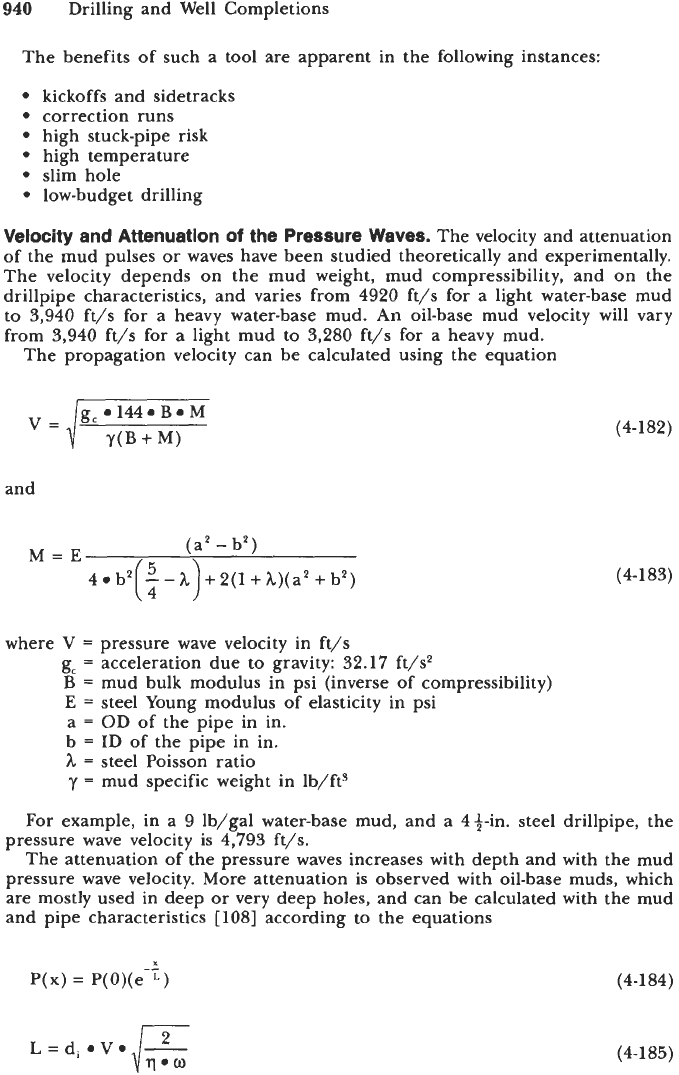
940
Drilling and Well Completions
The benefits of such a tool are apparent in the following instances:
kickoffs and sidetracks
correction runs
high stuck-pipe risk
high temperature
slim hole
low-budget drilling
Velocity
and Attenuation
of
the Pressure Waves.
The velocity and attenuation
of the mud pulses or waves have been studied theoretically and experimentally.
The velocity depends on the mud weight, mud compressibility, and on the
drillpipe characteristics, and varies from
4920
ft/s for a light water-base mud
to
3,940
ft/s for a heavy water-base mud. An oil-base mud velocity will vary
from
3,940
ft/s for a light mud to
3,280
ft/s for a heavy mud.
The propagation velocity can be calculated using the equation
and
(a'
-
b2)
4
b2(
f
-
1)+2(1+
1)(a2
+
b2)
M=E
(4-182)
(4-1 83)
where
V
=
pressure wave velocity in ft/s
g,
=
acceleration due to gravity:
32.17
ft/s2
B
=
mud bulk modulus in psi (inverse of compressibility)
E
=
steel Young modulus of elasticity in psi
a
=
OD of the pipe in in.
b
=
ID of the pipe in in.
h
=
steel Poisson ratio
y
=
mud specific weight in lb/ft3
For example, in a
9
lb/gal water-base mud, and a 44-in. steel drillpipe, the
pressure wave velocity
is
4,793
ft/s.
The attenuation of the pressure waves increases with depth and with the mud
pressure wave velocity. More attenuation is observed with oil-base muds, which
are mostly used in deep or very deep holes, and can be calculated with the mud
and pipe characteristics
[
1081
according to the equations
x
--
P(x)
=
P(O)(e
")
(4-
184)
(4-185)
L
=
di
0V.E
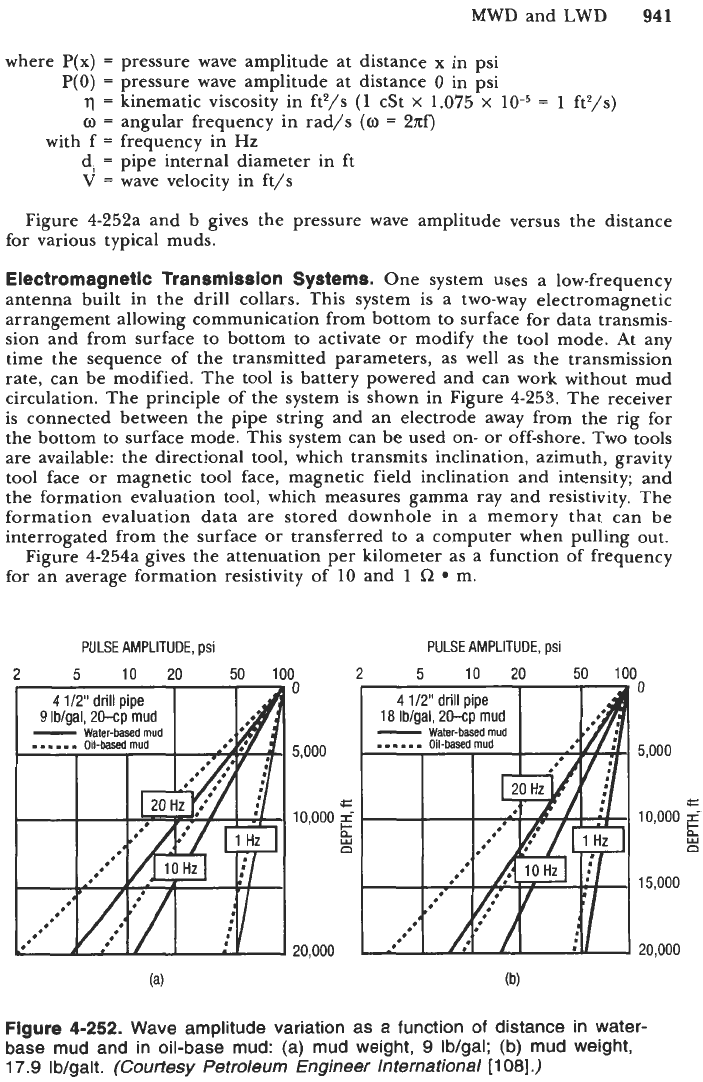
MWD and LWD
941
where
P(x)
=
pressure wave amplitude at distance
x
in psi
P(0)
=
pressure wave amplitude at distance
0
in psi
q
=
kinematic viscosity in ft2/s
(1
cSt
x
1.075
x
w
=
angular frequency in rad/s
(0
=
2x0
di
=
pipe internal diameter in ft
V
=
wave velocity in ft/s
=
1
ft2/s)
with
f
=
frequency in Hz
Figure 4-252a and b gives the pressure wave amplitude versus the distance
for various typical muds.
Electromagnetic Transmission Systems.
One system uses a low-frequency
antenna built in the drill collars. This system is a two-way electromagnetic
arrangement allowing communication from bottom to surface for data transmis-
sion and from surface to bottom to activate or modify the tool mode. At any
time the sequence of the transmitted parameters, as well as the transmission
rate, can be modified. The tool is battery powered and can work without mud
circulation. The principle of the system is shown in Figure 4-253. The receiver
is connected between the pipe string and an electrode away from the rig for
the bottom to surface mode. This system can be used on-
or
off-shore. Two tools
are available: the directional tool, which transmits inclination, azimuth, gravity
tool face or magnetic tool face, magnetic field inclination and intensity; and
the formation evaluation tool, which measures gamma ray and resistivity. The
formation evaluation data are stored downhole in a memory that can be
interrogated from the surface
or
transferred to a computer when pulling out.
Figure 4-254a gives the attenuation per kilometer as a function of frequency
for an average formation resistivity of
10
and
1
Q
m.
PULSE AMPLITUDE,
psi
2
5
10
20
50
100
0
5,000
a=
10,000
i
20,000
PULSE AMPLITUDE,
psi
5
10
20
50
1
0
5,000
.z
10,000
I-
L
n
15,000
20,000
Figure
4-252.
Wave amplitude variation
as
a function
of
distance in water-
base mud and in oil-base mud: (a) mud weight,
9
Ib/gal; (b) mud weight,
17.9
Ib/galt.
(Courtesy Petroleum Engineer International
[108].)
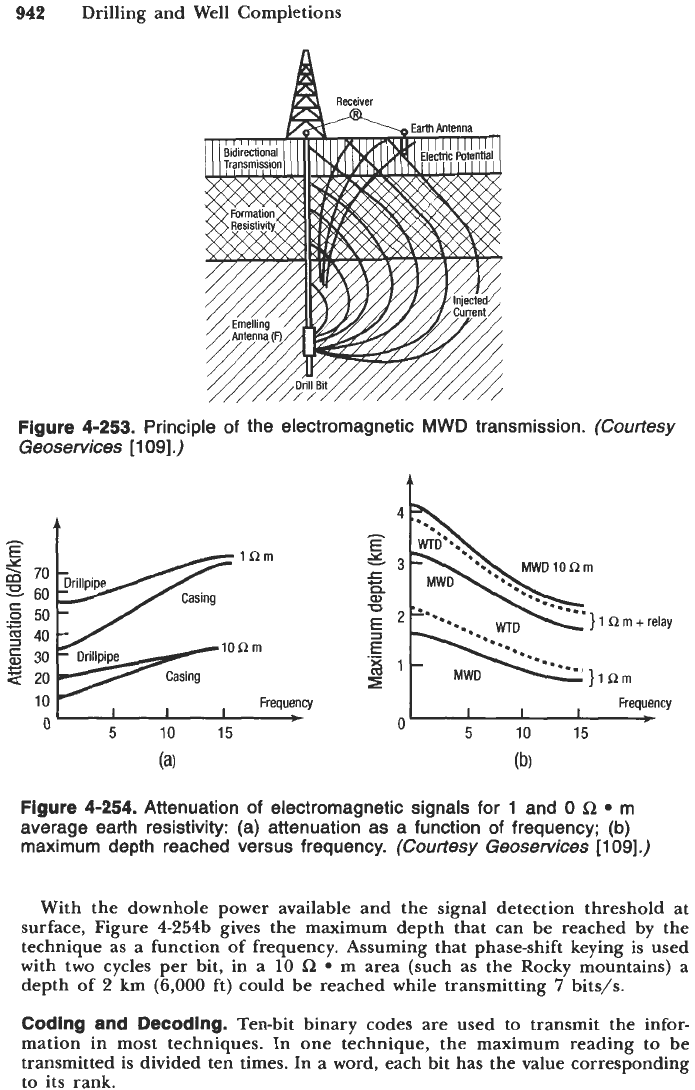
942
Drilling and Well Completions
Figure
4-253. Principle
of
the electromagnetic
MWD
transmission.
(Courtesy
Geoservices
[log].)
t
A
h
I I
I
Frequency
Frequency
*
I
I
*
5
10
15
0
5
10
15
0
(a)
(b)
Figure
4-254. Attenuation of electromagnetic signals for 1 and
0
a
m
average earth resistivity: (a) attenuation as a function of frequency;
(b)
maximum depth reached versus frequency.
(Courtesy Geoservices
[log].)
With the downhole power available and the signal detection threshold at
surface, Figure 4-254b gives the maximum depth that can be reached by the
technique as a function
of
frequency. Assuming that phase-shift keying is used
with two cycles per bit, in a
10
m area (such
as
the Rocky mountains) a
depth of 2 km
(6,000
ft) could be reached while transmitting
7
bits/s.
Coding and Decoding.
Ten-bit binary codes are used
to
transmit the infor-
mation in most techniques. In one technique, the maximum reading to be
transmitted is divided ten times. In a word, each bit has the value corresponding
to its rank.
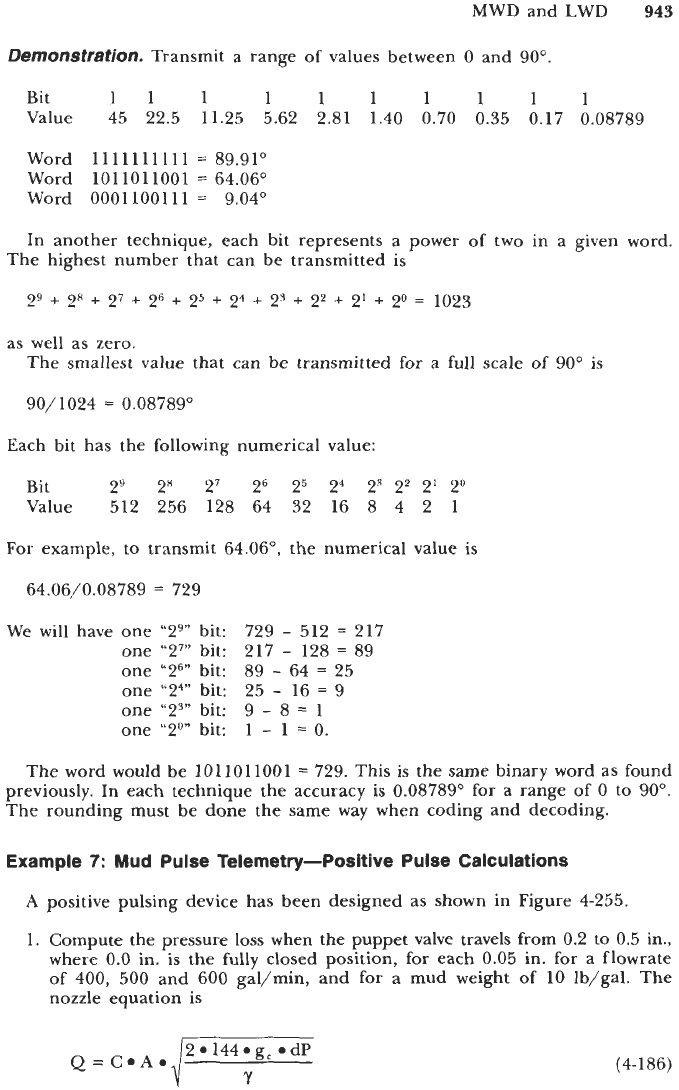
MWD and LWD
943
Demonstration,
Transmit a range of values between
0
and
90".
Bit
11
1
1111111
Value
45 22.5 11.25 5.62 2.81 1.40 0.70 0.35 0.17 0.08789
Word
1111111111
=
89.91"
Word
1011011001
=
64.06'
Word
0001100111
=
9.04"
In another technique, each bit represents a power of two in a given word.
The highest number that can be transmitted is
as
well
as
zero.
The smallest value that can be transmitted
for
a full scale
of
90"
is
90/1024
=
0.08789"
Each bit has the following numerical value:
Bit
29
2x
27 26
25 24 23 22 21
20
Value
512 256 128 64 32 16
8
4 2
1
For
example, to transmit
64.06",
the numerical value is
64.06,/0.08789
=
729
We will have one
''29"
bit:
one
Y7"
bit:
217
-
128
=
89
one
'Y"
bit:
one
Y4"
bit:
25
-
16
=
9
one
'Y"
bit:
9
-
8
=
1
one
"2°"
bit:
1
-
1
=
0.
729
-
512
=
217
89
-
64
=
25
The word would be
1011011001
=
729.
This
is
the same binary word as found
previously. In each technique the accuracy is
0.08'789"
for
a
range of
0
to
90".
The rounding must be done the same way when coding and decoding.
Example
7:
Mud Pulse Telemetry-Positive Pulse Calculations
A
positive pulsing device has been designed as shown in Figure
4-255.
1.
Compute the pressure loss when the puppet valve travels from
0.2
to
0.5
in.,
where
0.0
in. is the fully closed position, for each
0.05
in. for a flowrate
of
400,
500
and
600
gal/min, and for a mud weight of
10
Ib/gal. The
nozzle equation is
Q
=
c
A
i;"y
*144*g,
*dP
(4-186)
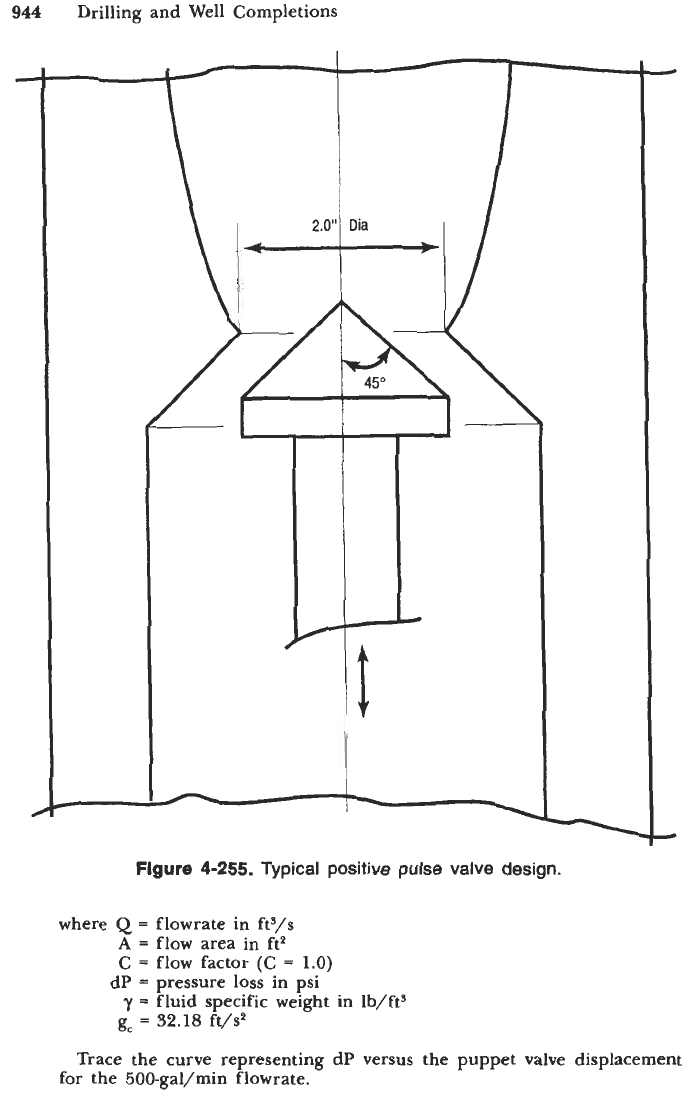
944
Drilling and Well Completions
d
I
t
Flgure
4-255.
Typical positive pulse valve design.
where
Q
=
flowrate in ft3/s
A
=
flow area in ft2
C
=
flow factor
(C
=
1.0)
y
=
fluid specific weight in lb/fts
dP
=
pressure loss in psi
g,
=
32.18
ft/s2
Trace the curve representing dP versus the puppet valve displacement
for the 500-gal/min flowrate.
